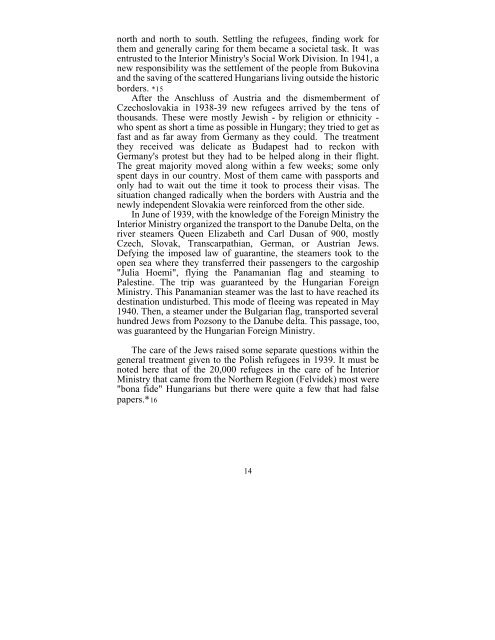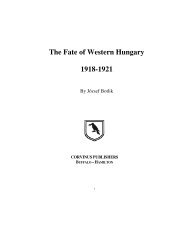the text - Corvinus Library - Hungarian History
the text - Corvinus Library - Hungarian History
the text - Corvinus Library - Hungarian History
You also want an ePaper? Increase the reach of your titles
YUMPU automatically turns print PDFs into web optimized ePapers that Google loves.
north and north to south. Settling <strong>the</strong> refugees, finding work for<br />
<strong>the</strong>m and generally caring for <strong>the</strong>m became a societal task. It was<br />
entrusted to <strong>the</strong> Interior Ministry's Social Work Division. In 1941, a<br />
new responsibility was <strong>the</strong> settlement of <strong>the</strong> people from Bukovina<br />
and <strong>the</strong> saving of <strong>the</strong> scattered <strong>Hungarian</strong>s living outside <strong>the</strong> historic<br />
borders. *15<br />
After <strong>the</strong> Anschluss of Austria and <strong>the</strong> dismemberment of<br />
Czechoslovakia in 1938-39 new refugees arrived by <strong>the</strong> tens of<br />
thousands. These were mostly Jewish - by religion or ethnicity -<br />
who spent as short a time as possible in Hungary; <strong>the</strong>y tried to get as<br />
fast and as far away from Germany as <strong>the</strong>y could. The treatment<br />
<strong>the</strong>y received was delicate as Budapest had to reckon with<br />
Germany's protest but <strong>the</strong>y had to be helped along in <strong>the</strong>ir flight.<br />
The great majority moved along within a few weeks; some only<br />
spent days in our country. Most of <strong>the</strong>m came with passports and<br />
only had to wait out <strong>the</strong> time it took to process <strong>the</strong>ir visas. The<br />
situation changed radically when <strong>the</strong> borders with Austria and <strong>the</strong><br />
newly independent Slovakia were reinforced from <strong>the</strong> o<strong>the</strong>r side.<br />
In June of 1939, with <strong>the</strong> knowledge of <strong>the</strong> Foreign Ministry <strong>the</strong><br />
Interior Ministry organized <strong>the</strong> transport to <strong>the</strong> Danube Delta, on <strong>the</strong><br />
river steamers Queen Elizabeth and Carl Dusan of 900, mostly<br />
Czech, Slovak, Transcarpathian, German, or Austrian Jews.<br />
Defying <strong>the</strong> imposed law of guarantine, <strong>the</strong> steamers took to <strong>the</strong><br />
open sea where <strong>the</strong>y transferred <strong>the</strong>ir passengers to <strong>the</strong> cargoship<br />
"Julia Hoemi", flying <strong>the</strong> Panamanian flag and steaming to<br />
Palestine. The trip was guaranteed by <strong>the</strong> <strong>Hungarian</strong> Foreign<br />
Ministry. This Panamanian steamer was <strong>the</strong> last to have reached its<br />
destination undisturbed. This mode of fleeing was repeated in May<br />
1940. Then, a steamer under <strong>the</strong> Bulgarian flag, transported several<br />
hundred Jews from Pozsony to <strong>the</strong> Danube delta. This passage, too,<br />
was guaranteed by <strong>the</strong> <strong>Hungarian</strong> Foreign Ministry.<br />
The care of <strong>the</strong> Jews raised some separate questions within <strong>the</strong><br />
general treatment given to <strong>the</strong> Polish refugees in 1939. It must be<br />
noted here that of <strong>the</strong> 20,000 refugees in <strong>the</strong> care of he Interior<br />
Ministry that came from <strong>the</strong> Nor<strong>the</strong>rn Region (Felvidek) most were<br />
"bona fide" <strong>Hungarian</strong>s but <strong>the</strong>re were quite a few that had false<br />
papers.*16<br />
14
















